Spatiotemporal shoreline change in Boushehr Province coasts, Iran
Saeed ZEINALI, Nasser TALEBBEYDOKHTI, Maryam DEHGHANI
Department of Civil & Environmental Engineering, School of Engineering, Shiraz University, Shiraz 71348-51156, Iran
Received Jan. 11, 2019; accepted in principle May 6, 2019; accepted for publication Jul. 3, 2019 © Chinese Society for Oceanology and Limnology, Science Press and Springer-Verlag GmbH Germany, part of Springer Nature 2020
Abstract Since coastal areas have highly dynamic nature and are one of the most benefi cial regions of civilizations, it is of great signifi cance to understand their characteristics and behavior. Changes in shorelines in the form of accretion and erosion can leave devastating efference ects on businesses and cities located along the shore. In this study, we statistically calculated the tendency of shoreline changes by processing and analyzing historical satellite images of Boushehr Province, Iran. Results show that these shores have experienced both sedimentation and erosion in the past 30 years. Net shoreline movement presents more than 350 m of erosion and 650 m of accretion, which are corresponded to change rates of almost 12 and 22 m/a, respectively. Statistics of shoreline changes are calculated from regression methods including end point rate, linear regression rate, weighted linear regression, and least median of squares. The best-performed method is applied to predict the shoreline position in 2050 and 2100. Potential locations of excessive changes are identifi ed for the predicted shorelines, which should be dealt with properly.
Keyword: digital shoreline analysis system; satellite image; accretion and erosion; linear regression; sediment; Boushehr Province
1 INTRODUCTION
Shoreline has been identifi ed as one of 27 important phenomena by the International Geographic Data Committee (IGDC) (Kuleli et al., 2011). Due to complicated behavior and dynamics of shorelines, they experience temporal and spatial changes, and evolve continuously over time (Stive et al., 2002; Miller and Dean, 2004; Stive et al., 2009). They experience both long term as well as short terms variations, caused by hydrodynamic processes, (e.g. river cycles, sea level rise), geomorphological phenomena (e.g. barrier island formation, spit development), and other factors (e.g. sudden and rapid seismic and storm events) (Scott, 2005). Shoreline changes are greatly concerned in many coastal areas (Genz et al., 2007). The study of shoreline evolution and its change rate is important for a broad range of coastal studies. These studies are mainly about shoreline advance and retreat (Chalabi et al., 2006; Qiao et al., 2018), construction planning (Mani et al., 1997), regional sediment budget (Kaminsky et al., 2000) and coastal morphodynamic prediction (Zeinali et al., 2016).
There have been so many methods in studying coastal and shoreline evolution. Each has been used in so many studies and their performances have been reported in the literature. Some of these methods could pointed out as numerical models based on historical data (Adamo et al., 2014), Monte-Carlo (Davidson et al., 2010; Banno and Kuriyama, 2014), mathematical models (Kaewpoo et al., 2012), models based on regime equations (Leont’yev, 2012) and those using data assimilation (Vitousek et al., 2017). Although these methods are very reliable and sophisticated, they might have some defects. The need for a huge amount of input data, which are mostly fi eld data, increases the computational cost and efference ort for modeling. The fact that fi eld data for shoreline modeling must usually be obtained at the same time of each year, makes some of the historically recorded data useless. In addition, recorded data should be taken along the shore on a particular time during a day, because of tidal variations. This will require a signifi cant number of human power or a long period of data acquisition (Chen and Chang, 2009). Fairly, most of these models are site-specifi c and could be used for a particular area (Moosavi et al., 2016). Due to the complexity of coastal areas and the signifi cance of afference ecting parameters, these models may exclude some parameters for the sake of simplifi cation. Therefore, using a simpler method with fewer simplifi cations and trustable results can be advantageous.
Ground-based surveys of rapidly changing landscapes are intrinsically complicated and expensive (Mills et al., 2005). Subsequently, most of the world's coastline morphology has not been quantifi ed suき ciently. However, improvements in coastal studies suggest that remote sensing and geographical information system (GIS) are very useful tools and make the studies easier (Yamano et al., 2006). Remote sensing enables us to record the current location of shoreline rapidly and easily as well (Addo et al., 2008). The application of satellite images simply provides images of the study area for the desired period and acquisition date (Chen and Rau, 1998; Mishra et al., 2019). In addition, these images have recorded the efference ect of all dominant parameters on the coastal area and shoreline. Therefore, no unnecessary simplifying assumption is required. Furthermore, the fact that the satellite images are available for any study makes it globally applicable. Finally, it can be pointed out that these valuable data can be used for change prediction, which is key information for long-term management planning.
The rate calculation is carried out by regression methods, e.g. end point rate (EPR). These methods are applied to enquire change rate statistically, over the study period based on the formulation of each method. The distance of shorelines from a userdefi ned baseline in difference erent years of acquired images and their temporal intervals are the input information of these methods. Some of them include the reliability of each extracted shoreline, while others deal with all shorelines equally, and similarly. The performance of each method is the key factor to be chosen for further steps of this study. These approaches are discussed and examined widely in the literature. An automatic analytical techniques using a geographical information system (GIS) and a digital shoreline analysis system (DSAS) were applied to analyze shoreline change rates along the 20 km Kenitra coast, Morocco (Moussiad et al., 2015). Jijelian sandy coast in East Algeria was studied and the statistics of shoreline changes were illuminated thoroughly using Quick-Bird satellite images covering the period 1960-2014 (Kermani et al., 2016). In another study, a selfdeveloped shoreline analysis program was used to analyze shoreline changes extracted from aerial photos for southwestern France (Castelle et al., 2018) with almost 270 km of high-energy sandy coast. A similar procedure was used to analyze change rates in the Goku Delta, Turkey, where fi ve Landsat images between 1984 and 2011 were used for shoreline extraction. Then shoreline change envelope (SCE), EP rate, and linear regression (LR) rate were the methods to calculate change rates (Ciritci and Türk, 2019).
The selected study area is of great importance in several aspects due to the diverse activities along its sandy shores. Accordingly, the core objectives of this study were to analyze shoreline changes in the study area, calculate change rates, and estimate the future position of the shoreline. The statistical results of this study could give a better understanding of the patterns of sediment movement in the area, and hopefully could be used to estimate the direction of longshore erosion and sedimentation in future studies.
2 STUDY AREA
Boushehr Province is located in the south Iran, on the shores of the Persian Gulf. Shorelines of this province are chosen for monitoring (Fig.1). This region is of value because it holds subareas with industrial, economic, municipal and tourism activities. Each of these activities and communities in a coastal area is crucial enough to justify the importance of this study. Asaluyeh is the heart of oil and gas production in Iran is also located in this area. Also, other municipal communities of this region such as Shirino and Nakhl Taghi ports, are highly dependent on fi shing. Furthermore, Nayband Bay is a visiting target for tourists because of clean water and diverse shoreline. Altogether, to fi nd the nature of shoreline changes in this area can be a fundamental element for shoreline management.

Table 1 Acquisition information of images
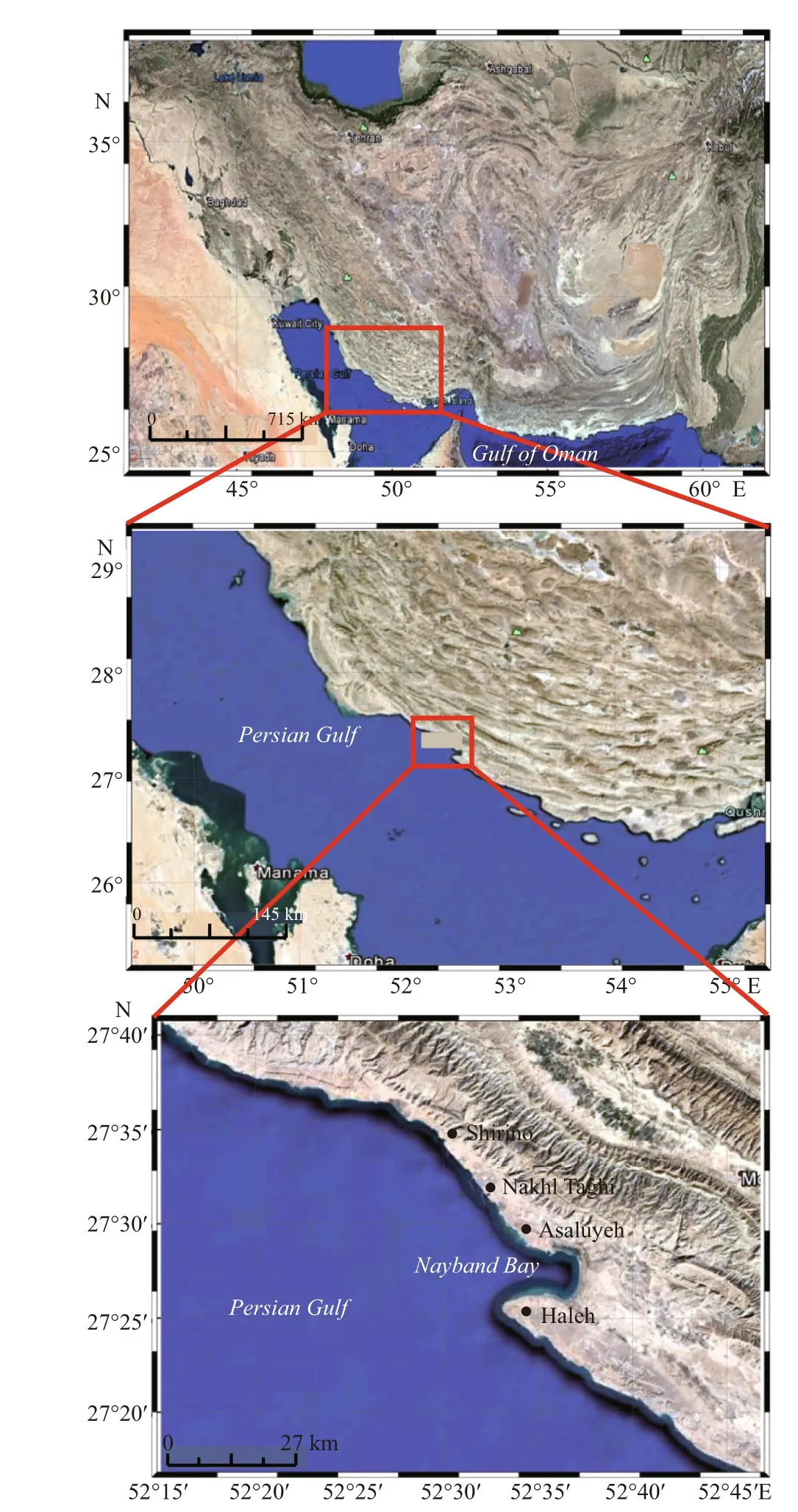
Fig.1 Location of the study area in Iran and along Persian Gulf beaches
The signifi cance of the Asaluyeh oil and gas industry has afference ected the area in several ways. First, the shoreline in this industrial zone has been disturbed enormously in time. Second, this industry has attracted population to neighboring urban areas. Accordingly, constructions along shores have recently increased a great deal (Ebadati et al., 2018).
The study area is from Shirino port to Haleh beach. The average annual rainfall in this area is 157.32 mm. In addition, the tidal range is 2.11 m on average, with variation from 0.7 to 3.32 m during neap and spring tides, respectively (Kalantari et al., 2012). Most of the sediment transport in this area is caused by wave difference raction and tidal currents. This area is exposed to waves traveling mostly in the northwest to southeast direction, creating longshore sediment transport. An approximate amount of 21 000 m3sediments per year moves along the shore in this area (Sami et al., 2010).
3 MATERIAL AND METHOD
Satellite images are the main materials for this study, and here Landsat images with 30-m pixel size, have been used from difference erent sensors for covering the period of the study. Satellite data over the study area for the period from 1987 to 2017 have been acquired. These data are from Landsat satellite sensors, i.e. Thematic Mapper (TM), Enhanced Thematic Mapper (ETM)+ and Operational Land Imager (OLI). The acquired data are listed in Table 1.
The next step is to extract the shoreline from each image. For this purpose, three steps must be taken. First, a water body in each image should be highlighted by the normalized difference erence water index (NDWI). Then the image should be divided into two categories by thresholding. Finally, shoreline must be obtained by the morphology fi lter as the edge of two categories. Each of these actions is explained in detail, in Section 3.1.
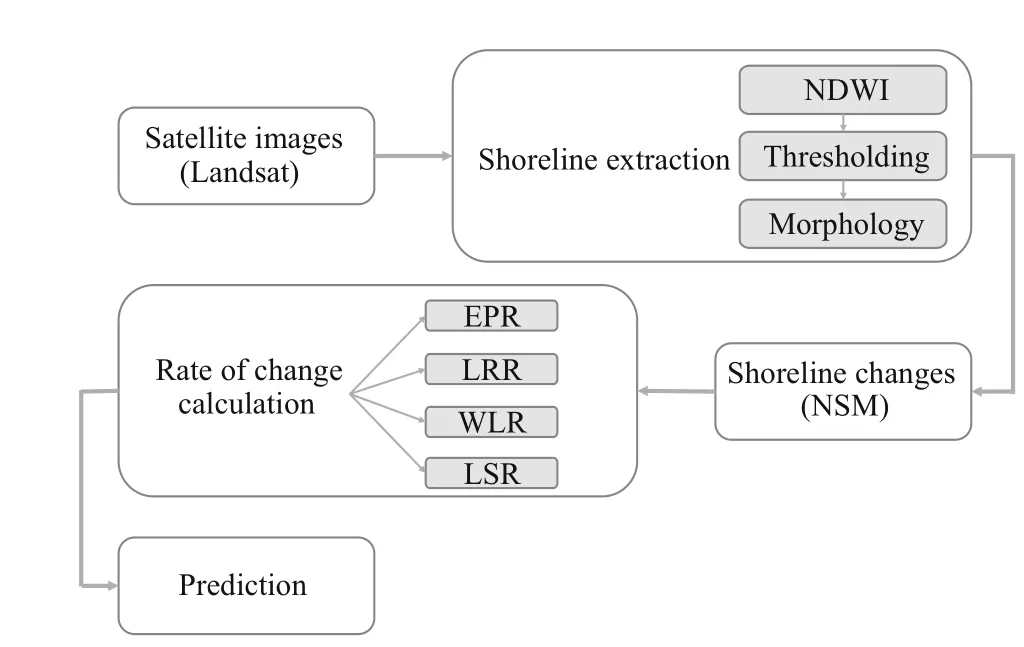
Fig.2 Flowchart of methodology
Then, the changes in the location of the extracted shoreline in the direction of perpendicular to shoreline must be identifi ed. For this part, transects are introduced in constant intervals along the shoreline whose intersections with the shoreline in difference erent dates give shoreline movement in time. Eventually, temporal changes along each transect are calculated by these locations. Net shoreline movement (NSM) is a sample of shoreline change, which indicates the change between the fi rst and last acquired date.
Furthermore, these changes are used to calculate the rate of change along each transect, for instance, temporal changes divided by the acquired period. There exists a bulk of methods to calculate change rates, and four of them are used in this study. Results of all four methods are verifi ed by an available shoreline and their performance is compared.
Finally, the method with the best performance is applied to calculate the shoreline position for 2050 and 2100. These steps are illustrated in Fig.2.
3.1 Shoreline extraction
There are several methods to extract shoreline in a satellite image such as visual interpretation (Winarso and Budhiman, 2001), classifi cation (Yamani et al., 2011; Zeinali et al., 2017), band ratio and thresholding (Guariglia et al., 2006). The accuracy of visual interpretation is very dependent on the accuracy of the interpreter. This method is a subjective one with a high degree of approximation, which leads to low accuracy. On the other hand, the classifi cation method is based on the training data selected for each class. The classifi cation accuracy is therefore highly related to the accuracy of the training data.
For the extraction of open water features, an index, namely, the NDWI that uses two spectral channels can be applied. Consequently, the shoreline will be delineated as well. This criterion increases the contrast between water and land in an image. The NDWI is applied to every single pixel in the image (McFeeters, 1996). The resulted images are then applied by a thresholding equation. In thresholding of an image, I( x, y) contains both bright and dark objects. These objects may be difference erentiated by a straightforward equation called thresholding along with a value called T, that is the threshold magnitude decided statistically or empirically by the analyst. All the pixels which belong to the bright object are coded as 1, while the dark part is labeled by 0 (Singh, 1989). In order to indicate irregular objects in an image, morphological operations can be used. Morphological processing is a template-based operation that the template chosen by the operator establishes how the object in an image is modifi ed. This template operation is defi ned in terms of a structuring element (SE), which is efference ectively a template. In this template, the elements are either present or not present, and are often represented respectively by template entries of 1 and 0. One of these operations is erosion. As its name implies this operation has the efference ect of eroding, and thus reducing the size of an object. Members of the structuring element are named as S while O is the set of pixels from which the object is composed. A sample SE is addressed as Si,j, in which subscripts ( i, j) are the location of image pixel that the center of structuring element is placed on. The structuring element is said to be a subset of the object, if it is completely located inside the object, and it is written as Si,j⊆ O. The eroded object is the set of pixels that fi ts into the subset condition. If the set of pixels of the eroded object is named E then that object is expressed as (Richards, 2013):

The equation says that from all points of the original object, only the set of points that satisfy the subset condition (SE completely enclosed within original object) will form the eroded object. Erosion is represented by symbol . Deducing the eroded object from its original will efference ectively give the boundaries, since the boundaries are shrunk by erosion. This is written in the form of: where B( O) is the difference erence between the object and its eroded version as set of pixels (Richards, 2013).

3.2 Accuracy assessment
The processing of remotely sensed imagery and procedures of extracting shorelines introduces errors during shoreline change analysis. Therefore, to obtain reliable shoreline change statistics, three sources of uncertainties are considered in this study, i.e., digitizing error, pixel error, and rectifi cation error. Pixel error is calculated by the spatial resolution of the images. Georeferencing error is calculated from the standard deviation of the shoreline position from rectifi cation, and the standard deviation of the shoreline position from repeated digitization of the same part of coast by several operators could give the interpretation error. The overall shoreline error is derived from the above errors, which is the root mean squared errors (RMSE) for each acquisition date (Table 1).
3.3 Calculation of shoreline changing rate
All of the shorelines are overlaid simultaneously and a baseline is defi ned in the area, manually. This baseline is considered as a reference line for further steps.
Transects perpendicular to baseline at desired spacing (100 m) is then created. These transects intersect with each shoreline, casting measurement points. The rate of changes is then computed from the distance between the baseline and the intersection points. The rate-of-change statistics include NSM, EPR, LRR, least median of squares (LMS), and weighted linear regression (WLR) rate. Digital shoreline analysis system (DSAS) (Thieler et al., 2009) by the United States Geological Survey (USGS), an extension for ArcMAP, has been employed for this purpose.
The NSM reports a distance between a single shoreline corresponding to two particular dates. These two dates are the oldest and the most recent ones and the distance values are calculated along each transect. The EPR is calculated by dividing the values of NSM by the time elapsed between two shorelines (Thieler et al., 2009).

Easy computation and requiring only two shorelines in difference erent times are the main advantages of this method while the disadvantage is missing the major phenomenon or alteration between accretion and erosion of the shoreline in the elapsed time (Thieler et al., 2009).

A linear regression rate (LRR)-of-change statistic can be determined by fi tting a least-squares regression line to all shoreline points for a particular transect, in the form of (Genz et al., 2007): where D is the distance from baseline and T is shoreline date. The LRR is the slope of the line m, and b is the gain of the fi tted regression line. Then, if more reliable data are given with weight in determining a best-fi t line, the method is called the weighted linear regression. The weight ( w) is defi ned as a function of the variance in the uncertainty of the measurement (e) (Genz et al., 2007):

where e is shoreline uncertainty value. In ordinary and weighted linear regression, the best-fi t line is placed through the points in such a way as to minimize the sum of squared residuals. In the linear regression method, the sample data are used to calculate a mean ofference set, and the equation for the line is determined by minimizing this value so that the input points are positions as close to the regression line as possible. In the LMS method the median value of the squared residuals is used instead of the mean to determine the best-fi t equation for the line. This method is a more robust regression estimator that minimizes the infl uence of an anomalous outlier on the overall regression equation (Thieler et al., 2009).
3.4 Shoreline prediction
Images acquired from 1987 to 2011 are used for computing the statistics, as in training, while the image acquired in 2017 image is considered for validating. Performance of all methods are examined by using them to estimate 2017 shoreline and comparing their result with actual location of 2017 shoreline, across each transect. The performance criteria is mean absolute percentage error (MAPE) between the estimated and actual positions of 2017 shoreline intersected at all transects. The MAPE is a measure of prediction accuracy of a forecasting method in statistics. It expresses accuracy as a percentage, and is defi ned as:

where Atis the actual value and Ftis the forecast value. The difference erence between Atand Ftis divided by the Atagain. The absolute value in this calculation is summed for every forecasted points and divided by the number of fi tted point n. Multiplying by 100% makes it a percentage error (De Myttenaere et al., 2016).
Then it is assumed that the shoreline changes in time by the rate of the best-featured method after 2017. By that, a rough estimation of the shoreline location in 2050 and 2100 could be achieved.

Fig.3 Shoreline extraction for the image acquired in 2017
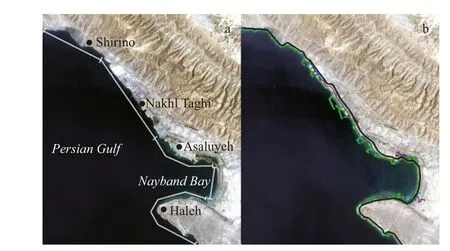
Fig.4 Subsets of the study area (a) and the shorelines extracted at acquisition dates and the defi ned baseline (black line) (b)
4 RESULT AND DISCUSSION
The whole process of extracting shorelines including applying the NDWI, thresholding and morphological fi ltering is elaborated in Fig.3.
For more detailed monitoring of the shoreline, the study area was divided into 5 difference erent subsets (Fig.4a). Shorelines extracted in all acquisition dates as well as the baseline defi ned for all subsets are plotted on the 2017 original image (Fig.4b). Transects were defi ned for the whole area for all acquisition dates. Moreover, 642 transects at 100 m intervals were automatically created along the shorelines. Latitude and longitude of top left transect are 27°38′59″N and 52°23′40″E, and those for the bottom right transect are 27°20′03″N and 52°38′44″E. The baseline was then defi ned on the landside of the shoreline, which is demonstrated in Fig.4b with a black bold line. The position of shorelines on all acquisition dates along the created transects, which is measured according to the baseline, is presented in Fig.5. Among all subsets, Nakhl Taghi shows signifi cant sedimentation from 1999 to 2005, which is due to the massive constructions on the shoreline and building several docks in the area that moved the shoreline seaward, dramatically. Another phase of constructions seems to have moved the shoreline in the same direction between transects 145 to 165 in the 2005-2017 period.
4.1 Net shoreline movement from 1987 to 2011
Shoreline changes along transects were calculated over the period of interest. The values of NSM are depicted in Fig.6. It can be observed that the main accretion happens on Nakhl Taghi due to massive constructions. The magnitude of changes are categorized into difference erent groups whose frequency are calculated in Fig.7. In this fi gure, the values of the whole area are depicted in Fig.7a, and in Fig.7b Nakhl Taghi is excluded for better analysis. From Fig.7a, we understand that accretion is dominant in this area (51.11%). Most of the accretion is less than 150 m and almost 13% of transects reports sedimentation more than 350 m. The maximum erosion is 360 m whereas maximum accretion is 680 m, which indicates that accretion has happened more signifi cantly. Because of local constructions in Nakhl Taghi, if we exclude this part of shoreline from the statistics, the maximum value of accretion changes to 310 m and erosion values remain constant. In this situation, erosion is dominant (60%) (Fig.7). Moreover, the fl uctuations in shoreline position in the period between 1987 and 2011, is presented in Fig.8. It suggests that most of the overall erosion has taken place between 1987 and 1993 and after that between 1999 and 2005. Maximum accretion, on the fl ip side, has happened from 1999 to 2005 and from 2005 to 2011. The construction that is talked about on the Nakhl Taghi subset has been made during the 1999-2005 period, which is between transects 170 and 245. Also, this constructions goes on to take place on Nakhl Taghi subset during the 2005-2011 period between transects 145 to 165. Not taking into consideration these considerable changes, during two time periods 1993 to 1999 and 2005 to 2011, accretion is dominant in most of the transects, and erosion is recorded mostly in the last transects.
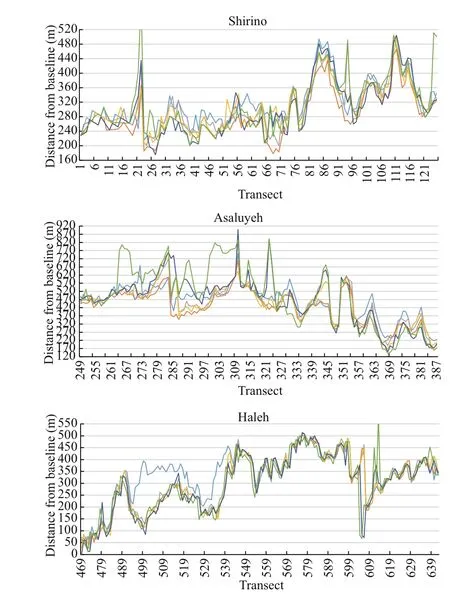

Fig.5 Position of shoreline on all acquisition dates along the created transects
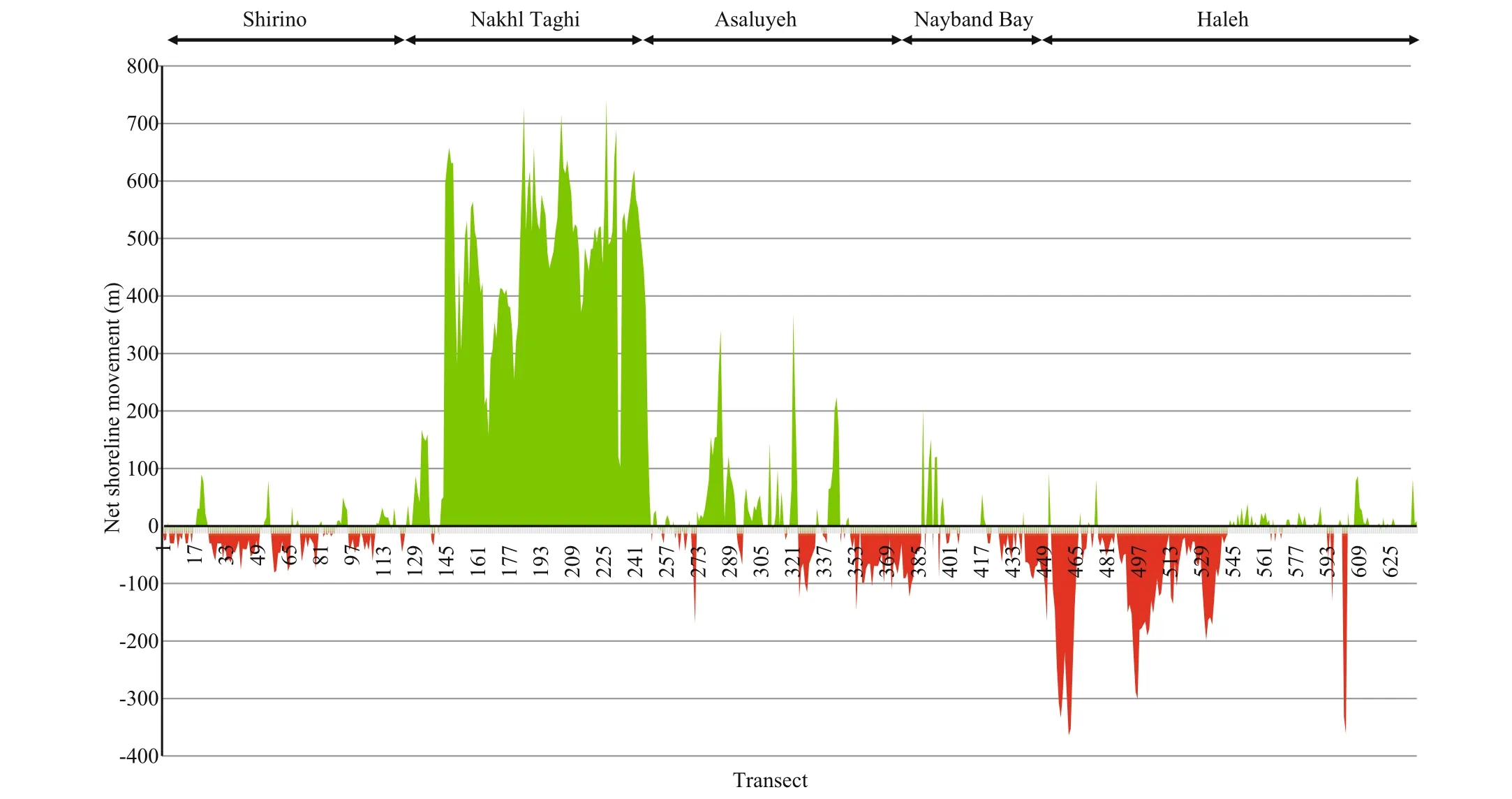
Fig.6 Net Shoreline Movement in the study area (1987-2011)
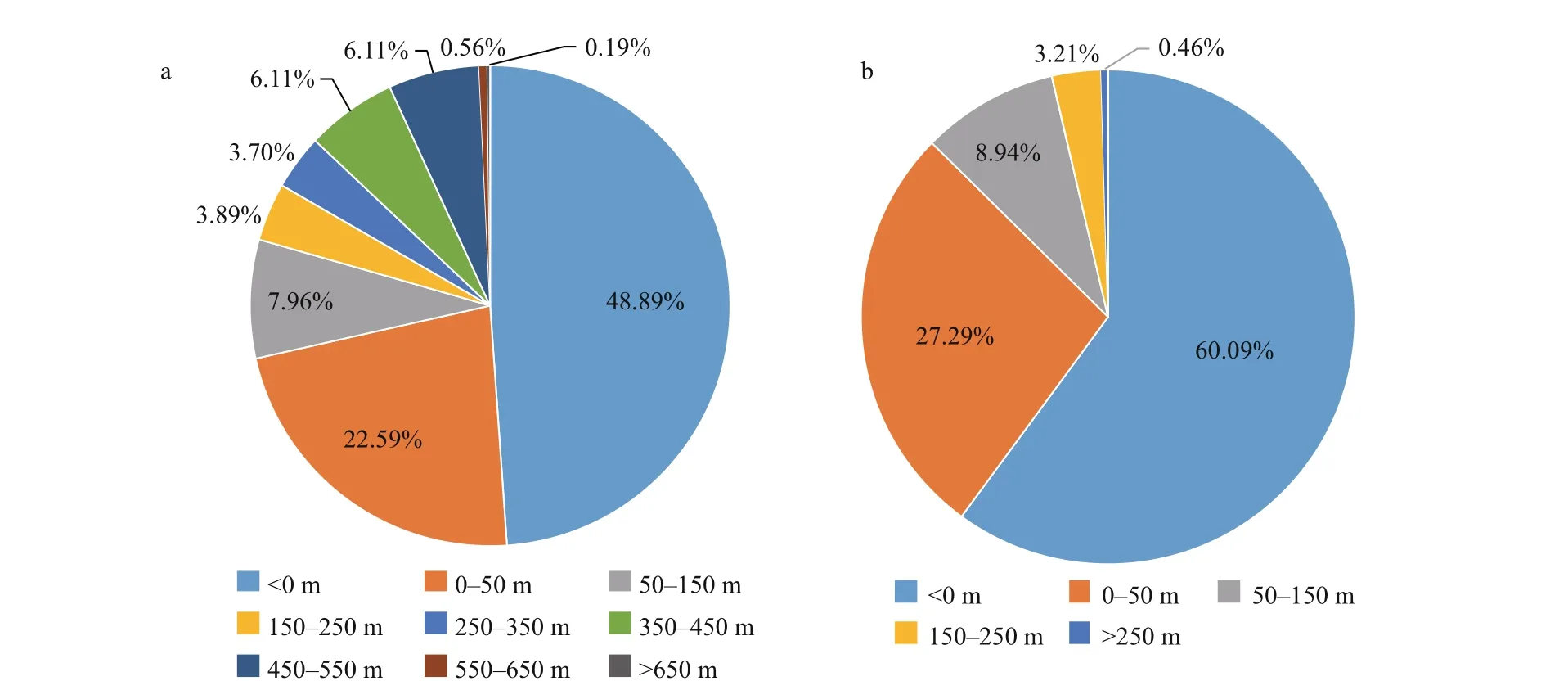
Fig.7 Frequency of shoreline changes
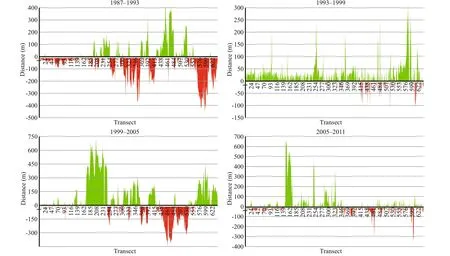
Fig.8 Net shoreline movements between acquired dates
4.2 Rate-of-change analysis and prediction
Rate-of-change statistical approaches have widely been used to obtain reliable results in time-series studies of satellite images, despite the inconsistencies and variations in their accuracy (Douglas and Crowell, 2000; Maiti and Bhattacharaya, 2009; Santra et al., 2011). The rate-of-change along all transects extracted from difference erent methods including EPR, LRR, WLR, and LMS were calculated (Fig.9). As observed, the fi rst three methods have a similar behavior in almost all of the transects. In certain parts of the shoreline, however, the LMS method resulted in difference erent rates.
For a more detailed study of shoreline changes in this area, statistics of change rates using three methods, i.e. LRR, WLR, and LMS, are compared in all fi ve subsets and illustrated in Figs.10 to 14, and Table 2.
All four methods were used to calculate change rates. These rates were then used to obtain the shoreline corresponding to 2017. The calculated shoreline location in 2017 and the actual one are compared for all subsets in Fig.15.
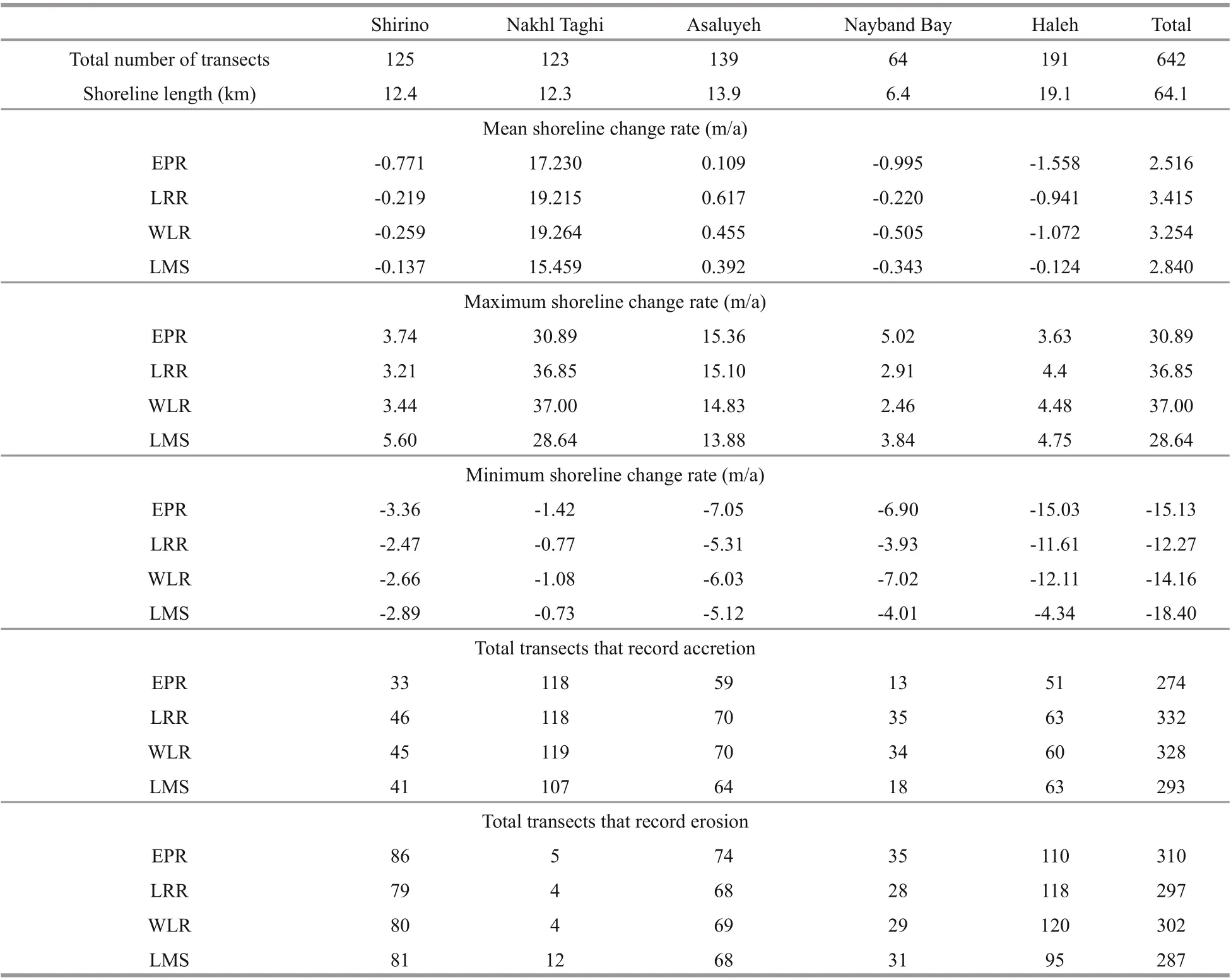
Table 2 Statistics for EPR, LRR, WLR, and LMS between 1987 and 2011

Fig.9 Rate of change along all transects from all methods
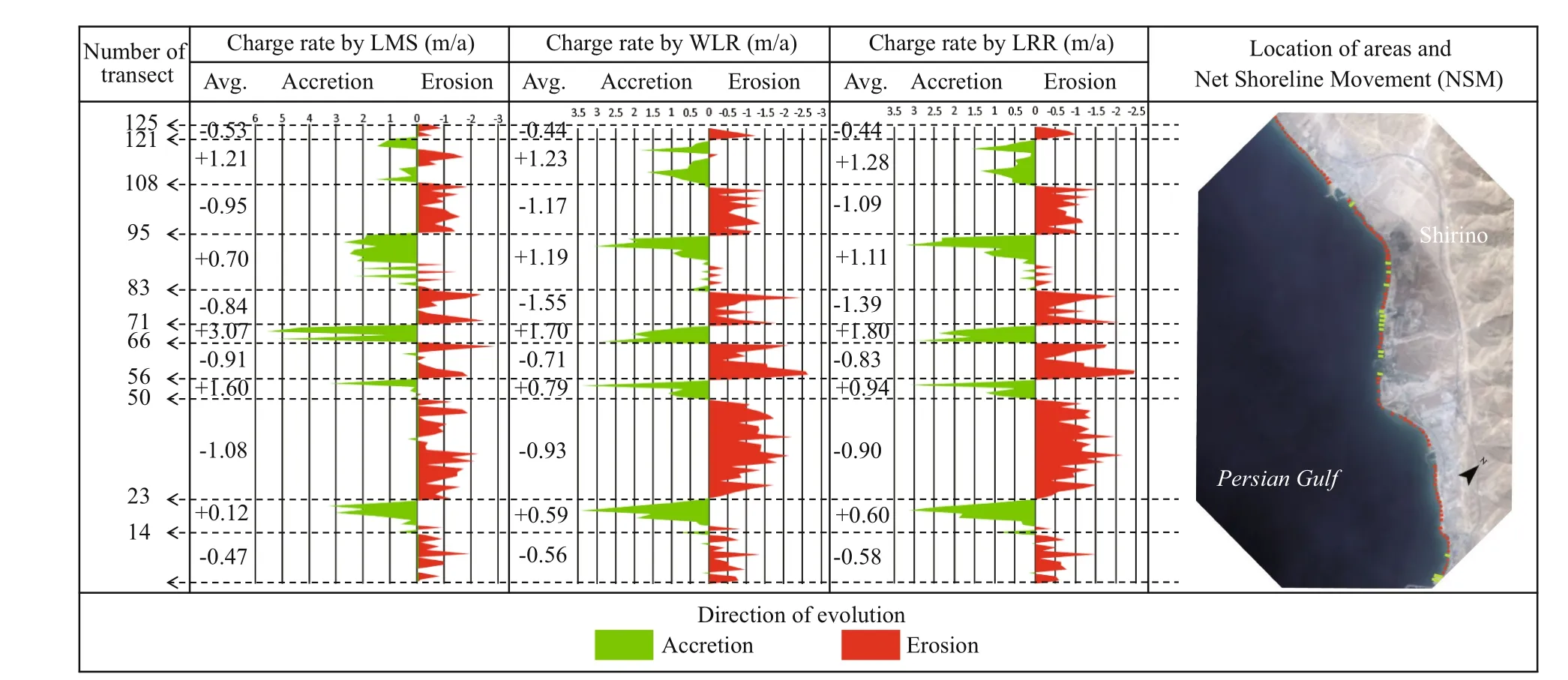
Fig.10 Change rates between 1987 and 2011 calculated by LRR, WLR, and LMS for Shirino subset
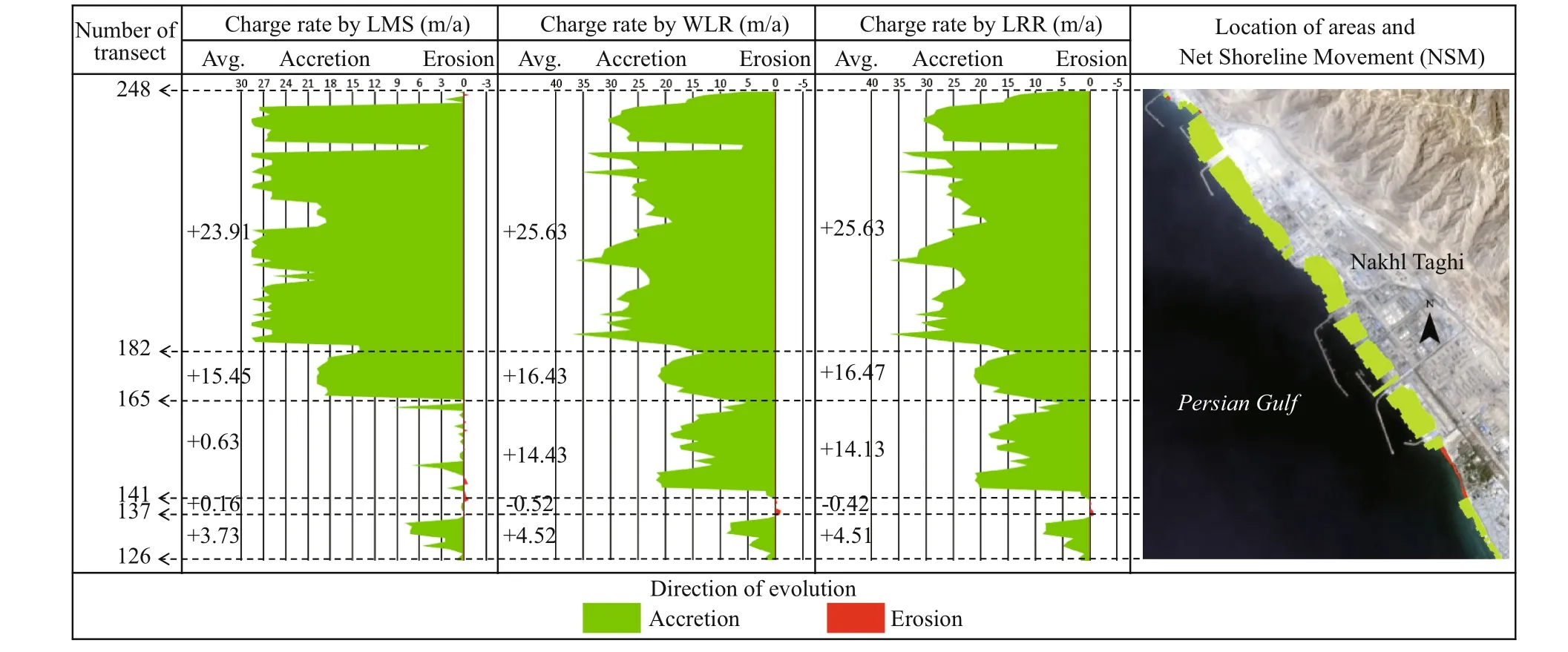
Fig.11 Change rates between 1987 and 2011 calculated by LRR, WLR, and LMS for Nakhl Taghi subset
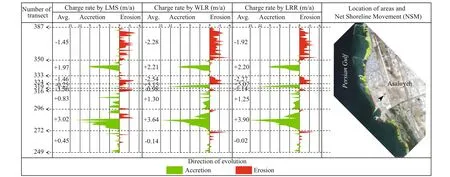
Fig.12 Change rates between 1987 and 2011 calculated by LRR, WLR, and LMS for Asaluyeh subset
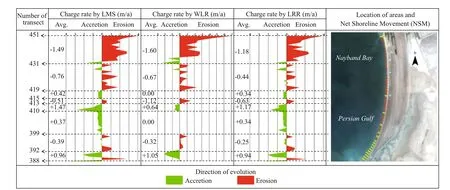
Fig.13 Change rates between 1987 and 2011 calculated by LRR, WLR, and LMS for Nayband Bay subset

Fig.14 Change rates between 1987 and 2011 calculated by LRR, WLR, and LMS for Haleh subset
With respect to Figs.10 to 14 and Table 2, it can be found out that on the Shirino sector, accretion has happened in greater rates but most of the transects experience erosion. Therefore, the mean change rate is negative. Most of the transects in the Nakhl Taghi sector are under accretion, and the main reason, as mentioned previously, is due to the construction of the oil and gas industry in this area. The mean change rate in this area is far greater than other sectors, and the maximum change rate is almost twice the rate in Asaluyeh and it is 10 times those of other sectors. These values are the results of human activities and could not be considered because of natural processes. The Asaluyeh sector starts with transects experiencing erosion and continues with accretion, which could be said that the eroded sediments in starting transects are deposited in fi nishing transects. It could also be verifi ed by the previously mentioned fact that the dominant wave direction in the region is northwest to southeast. Mean change rates are almost in balance with a slight favor in accretion. However, accretion rates are greater than erosion ones. For the Nayband Bay, mean change rates are towards erosion, and maximum and minimum rates are equal. In this subset, WLR reports a balanced condition between 399 and 410 transects, unlike LRR and LMS. Finally, the Haleh sector is dominated by erosion, which has taken place in the fi nal transects. In this sector, between transect 537 and 602; change rates are very low, which could be due to the rocky shores in this part.
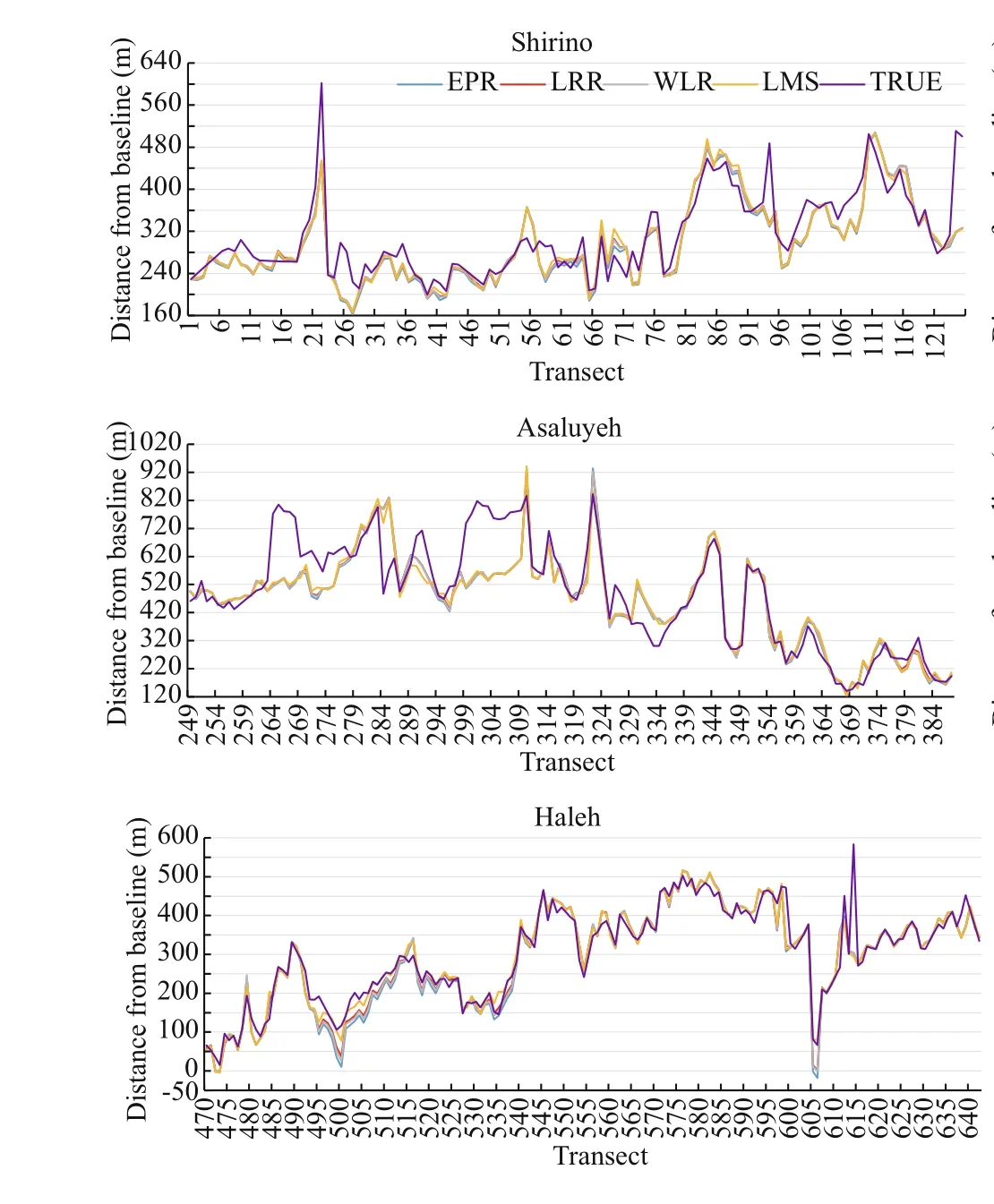
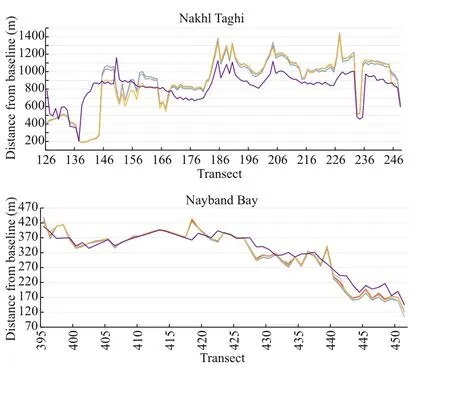
Fig.15 Estimated compared to extracted 2017 shoreline
For accuracy assessment of these methods, MAPE has been calculated between the available and calculated shoreline of 2017 (Table 3) and are compared in Fig.15. As presented, the least accuracy has been achieved on Nakhl Taghi, which has experienced massive constructions over time, and it has been an anomaly to the natural evolution of shoreline. Therefore, using statistical methods may refl ect results with low accuracy. However, there have been reliable results on the other subsets. Overall results showed that LMS has a fairly better result for predicting shoreline of the year 2017. Thereby, this method is used to predict long-term shoreline locations for years 2050 and 2100 (Fig.16). A prediction has been carried out by assuming that the change rates calculated by LMS, will continuously change the location of shoreline until targeted years. Therefore, the change rates are multiplied by 33 and 83 years, and then added to the location of shoreline in 2017, in order to gain location for the years 2050 and 2100, respectively. As observed previously, changes in Nakhl Taghi are remarkable. Since these changes are made by coastal structures, it does not seem to continue to change by the same rate, so such results can be ignored in predictions. The least amount of evolutions is happening in Haleh. That is because this part of shoreline mostly includes rocks and is, therefore, resistant against sedimentation and erosion.
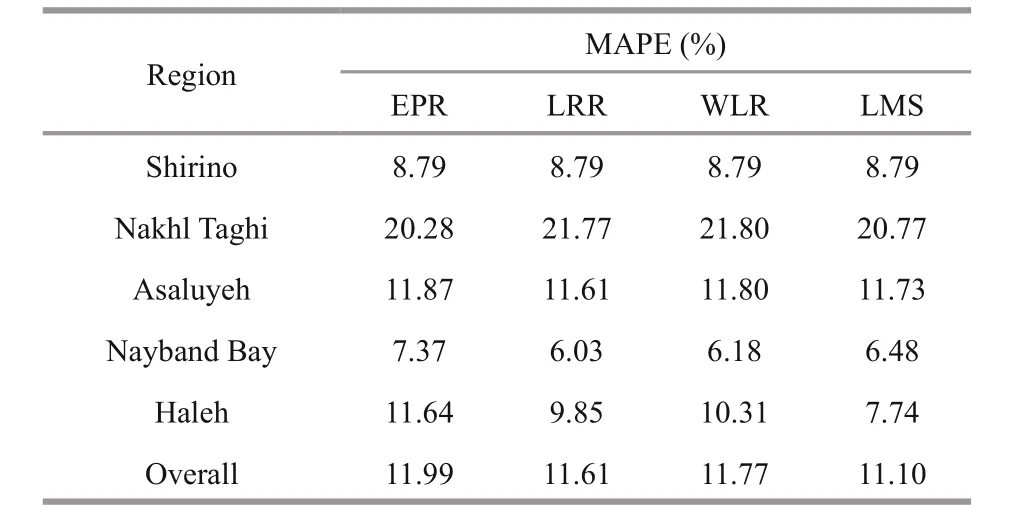
Table 3 Accuracy assessment of applied methods
In Shirino, the most fl uctuations are predicted near transects 21 and 66. These parts consist of two docks that obviously afference ect the natural longshore sediment fl ow and causes accretion and erosion around them. This matter can also be observed in Asaluyeh around transects 285, 310, and 345, with considerable accretion. A considerable amount of erosion can be detected at the end of Nayband Bay in which there is a river mouth. Obviously, the corresponding bank of the river mouth is eroding noticeably. At the beginning transects of Nayband Bay, accretion is dominant. This river is called the Gavbandi River that is a seasonal river. It carries currents only in about 3-4 months of a year when there is rainfall in the area. There is another river mouth there that experiences sedimentation. On the contrary, this river had been blocked farther inland, as the result of industrial constructions in the region.
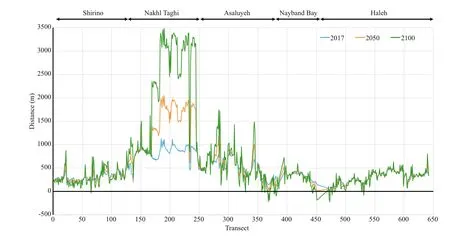
Fig.16 Estimated future shoreline position for 2050 and 2100 with respect to defi ned baseline
5 CONCLUSION
The most common event in coastal areas with commercial and trading activities is the accretion and erosion near dikes and ports. In this study, we analyzed the shoreline change rates and used them for prediction along Boushehr Province shorelines. In order to achieve reliable results, difference erent methods including EPR, LRR, WLR, and LMS were applied.
The results demonstrate that despite the part of shoreline that has undergone heavy constructions resulting in shoreline accretion, erosion is dominant in this area, which is the case for 60% of transects. Locally speaking, changes are greater around available docks in Shirino and Asaluyeh, which is due to disturbing the natural longshore sediment fl ow caused by northwest-southeast wave directions. The Nakhl Taghi sector had the highest accretion rates and the Haleh sector had the lowest negative rates. Considering the LMS with the best performance, the Shirino subset had a 0.14-m/a erosion rate, Nakhl Taghi had moved seaward with the rate of 15.46 m/a. Moreover, Asaluyeh had undergone accretion by the rate of 0.39 m/a, and both Nayband Bay and Haleh had eroded 0.34 and 0.12 m/a, respectively. Shirino and Haleh had the lowest change rate amongst all fi ve subsets, which were both eroded in time. Finally, rocky parts of shorelines in the Haleh subset had minuscule change rates.
The method with the best performance and lowest MAPE were used for future estimation. Using calculated values for estimating future shoreline position showed that considerable changes have taken place beside the constructed dikes and around river mouths, as expected. The future estimation shows some considerable accretion and erosion in certain transects. These magnitudes of changes emphasize the importance of this study as well as the application of results to design a protection plan for the shoreline. Although these estimations are based on historical change rates and might seem not accurate in reality, this prediction gives an approximate view of what future shoreline might look like if the present processes keep on going to happen.
6 DATA AVAILABILITY STATEMENT
The Landsat satellite images that support the fi ndings of this study are available in USGS’s Earth Explorer website https://earthexplorer.usgs.gov.
References
Adamo F, De Capua C, Filianoti P, Lanzolla A M L, Morello R. 2014. A coastal erosion model to predict shoreline changes. Measurement, 47: 734-740.
Addo K A, Walkden M, Mills J P. 2008. Detection, measurement and prediction of shoreline recession in Accra, Ghana. ISPRS J ournal of Photogrammetry and Remote Sensing, 63(5): 543-558.
Banno M, Kuriyama Y. 2014. Prediction of future shoreline change with sea-level rise and wave climate change at Hasaki, Japan. Coastal Engineering, 34: 1-10.
Castelle B, Guillot B, Marieu V, Chaumillon E, Hanquiez V, Bujan S, Poppeschi C. 2018. Spatial and temporal patterns of shoreline change of a 280-km high-energy disrupted sandy coast from 1950 to 2014: SW France. Estuarine, Coastal and Shelf Science, 200: 212-223.
Chalabi A, Mohd-Lokman H, Mohd-Suき an I, Karamali M, Karthigeyan V, Masita M. 2006. Monitoring shoreline change using IKONOS image and aerial photographs: a case study of Kuala Terengganu area, Malaysia. In: Proceedings of the ISPRS Mid-Term Symposium Proceeding. Enschede, Netherlands.
Chen L C, Rau J Y. 1998. Detection of shoreline changes for tideland areas using multi-temporal satellite images. International Journal of Remote Sensing, 19(17): 3 383-3 397.
Chen W W, Chang H K. 2009. Estimation of shoreline position and change from satellite images considering tidal variation. Estuarine, Coastal and Shelf Science, 84(1): 54-60.
Ciritci D, Türk T. 2019. Automatic detection of shoreline change by geographical information system (GIS) and remote sensing in the Göksu Delta, Turkey. J ournal of the Indian Society of Remote Sensing, 47(2): 233-243.
Davidson M A, Lewis R P, Turner I L. 2010. Forecasting seasonal to multi-year shoreline change. Coastal Engineering, 57(6): 620-629.
De Myttenaere A, Golden B, Le Grand B, Rossi F. 2016. Mean absolute percentage error for regression models. Neurocomputing, 192: 38-48.
Douglas B C, Crowell M. 2000. Long-term shoreline position prediction and error propagation. J ournal of Coastal Research, 16(1): 145-152.
Ebadati N, Razavian F, Khoshmanesh B. 2018. Investigating the trend of coastline changes in the port of Asalouyeh to Bandar Deir using RS and GIS techniques. Iranian J ournal of Ech oh ydrology, 5(2): 653-662.
Genz A S, Fletcher C H, Dunn R A, Frazer L N, Rooney J J. 2007. The predictive accuracy of shoreline change rate methods and alongshore beach variation on Maui, Hawaii. Journal of Coastal Research, 23(1): 87-105.https://doi.org/10.2112/05-0521.1.
Guariglia A, Buonamassa A, Losurdo A, Saladino R, Trivigno M L, Zaccagnino A, Colangelo A. 2006. A multisource approach for coastline mapping and identifi cation of shoreline changes. Annals of Geophysics, 49(1): 295-304.
Kaewpoo N, Nakhapakorn K, Pumijunong N, Silapathong C. 2012. The integration of GIS and mathematical model for shoreline prediction. In: The 33rdAsian Conference on Remote Sensing.
Kalantari N, Sajadi Z, Makvandi M, Keshavarzi M R. 2012. Chemical properties of soil and groundwater of the Assaluyeh alluvial plain with emphasis on heavy metals contamination. J. Geotechnical Geology ( Applied Geology), 7(4): 333-342.
Kaminsky G M, Buijsman M C, Ruggiero P. 2000. Predicting shoreline change at decadal scale in the Pacifi c Northwest, USA. In: 7thInternational Conference on Coastal Engineering. ASCE, Sydney, Australia. p.2 400-2 413.
Kermani S, Boutiba M, Guendouz M, Guettouche M S, Khelfani D. 2016. Detection and analysis of shoreline changes using geospatial tools and automatic computation: Case of jijelian sandy coast (East Algeria). Ocean & Coastal Management, 132: 46-58.
Kuleli T, Guneroglu A, Karsli F, Dihkan M. 2011. Automatic detection of shoreline change on coastal Ramsar wetlands of Turkey. Ocean Eng ineering, 38(10): 1 141-1 149.
Leont’yev I O. 2012. Predicting shoreline evolution on a centennial scale using the example of the Vistula (Baltic) spit. Oceanology, 52(5): 700-709.
Maiti S, Bhattacharya A K. 2009. Shoreline change analysis and its application to prediction: A remote sensing and statistics based approach. Marine Geology, 257(1-4): 11-23.
Mani J S, Murali K, Chitra K. 1997. Prediction of shoreline behaviour for Madras, India-a numerical approach. Ocean Eng ineering, 24(10): 967-984.
McFeeters S K. 1996. The use of the Normalized Difference erence Water Index (NDWI) in the delineation of open water features. International Journal of Remote Sensing, 17(7): 1 425-1 432.
Miller J K, Dean R G. 2004. A simple new shoreline change model. Coastal Engineering, 51(7): 531-556.
Mills J P, Buckley S J, Mitchell H L, Clarke P J, Edwards S J. 2005. A geomatics data integration technique for coastal change monitoring. Earth Surface Processes and Landforms, 30(6): 651-664.
Mishra V N, Prasad R, Kumar P, Gupta D K, Agarwal S, Gangwal A. 2019. Assessment of spatio-temporal changes in land use/land cover over a decade (2000-2014) using earth observation datasets: A case study of Varanasi district, India. Iranian J ournal of Science and Technology, Transaction of Civil Engineering, 43(S1): 383-401, https://doi.org/10.1007/s40996-018-0172-6
Moosavi L, Ab Ghafar N, Mahyuddin N. 2016. Investigation of thermal performance for Artia: a method overview. MATEC Web of Conference, 66: 00029.
Moussaid J, Fora A A, Zourarah B, Maanan M, Maanan M. 2015. Using automatic computation to analyze the rate of shoreline change on the Kenitra coast, Morocco. Ocean Engineering, 102: 71-77.
Qiao G, Mi H, Wang W A, Tong X H, Li Z B, Li T, Liu S J, Hong Y. 2018. 55-year (1960-2015) spatiotemporal shoreline change analysis using historical DISP and Landsat time series data in Shanghai. International Journal of Applied Earth Observation and Geoinformation, 68: 238-251.
Richards J A. 2013. Remote Sensing Digital Image Analysis: An Introduction. 5thedn. Springer Heidelberg, New York.
Sami S, Soltanpour M, Lak R. 2010. Sedimentology of the west coastlines of Nayband Bay and the impact of carbonate sediments on the sedimentation in Asaluyeh Fishery Port. J ournal of Marine Engineering, 6(11): 45-57.
Santra A, Mitra D, Mitra S. 2011. Spatial modeling using high resolution image for future shoreline prediction along Junput Coast, West Bengal, India. Geo- Spatial Information Science, 14(3): 157-163.
Scott D B. 2005. Encyclopaedia of Coastal Sciences. Springer, Netherlands.
Singh A. 1989. Digital change detection techniques using remotely-sensed data. International Journal of Remote Sensing, 10(6): 989-1 003.
Stive M J F, Aarninkhof S G J, Hamm L, Hanson H, Larson M, Wijnberg K M, Nicholls R J, Capobianco M. 2002. Variability of shore and shoreline evolution. Coastal Engineering, 47(2): 211-235.
Stive M J F, Ranasinghe R, Cowell P. 2009. Sea level rise and coastal erosion. In: Kim Y C ed. Handbook of Coastal and Ocean Engineering. World Scientifi c, Los Angeles, USA. p.1 023-1 038.
Thieler E R, Himmelstoss E A, Zichichi J L, Ergul A. 2009. Digital Shoreline Analysis System (DSAS) version 4.0—An ArcGIS extension for calculating shoreline change. U.S. Geological Survey Open-File Report 2008-1278, Current Version 4.3. U.S. Geological Survey.
Vitousek S, Barnard P L, Limber P L, Erikson L, Cole B. 2017. A model integrating longshore and cross-shore processes for predicting long-term shoreline response to climate change. J ournal of Geophysical Research: Earth Surface, 122(4): 782-806.
Winarso G, Judijanto A, Budhiman S. 2011. The potential application remote sensing data for coastal study. In: Paper Presented at the 22ndAsian Conference on Remote Sensing. Singapore.
Yamani M, Rahimi Harabadi S, Goudarzi Mehr S. 2011. Periodic changes of the east Strait of Hormuz shore line by remote sensing. Environmental Erosion Researches, Hormozgan University.
Yamano H, Shimazaki H, Matsunaga T, Ishoda A, McClennen C, Yokoki H, Fujita K, Osawa Y, Kayanne H. 2006. Evaluation of various satellite sensors for waterline extraction in a coral reef environment: Majuro Atoll, Marshall Islands. Geomorphology, 82(3-4): 398-411.
Zeinali S, Dehghani M, Rastegar M A, Mojarrad M. 2017. Detecting shoreline changes in Chabahar bay by processing satellite images. Scientia Iranica, 24(4): 1 802-1 809.
Zeinali S, Talebbeydokhti N, Saeidian M, Vosough S. 2016. Modeling of bed level changes in Larak Island. In: Proc. 18thInt. Conf. on Coastal and Ocean Eng., London.
 Journal of Oceanology and Limnology2020年3期
Journal of Oceanology and Limnology2020年3期
- Journal of Oceanology and Limnology的其它文章
- List of the Most Outstanding Papers Published by CJOL/JOL in 2017-2018
- Efference ects of dietary cottonseed meal protein hydrolysate on growth, antioxidants and immunity of Chinese mitten crab Eriocheir Sinensis*
- bHLH genes polymorphisms and their association with growth traits in the Pacifi c oyster Crassostrea gigas*
- Genetic variation within and among range-wide populations of three ecotypes of the Japanese grenadier anchovy Coilia nasus with implications to its conservation and management*
- Complete mitochondrial genomes of two deep-sea pandalid shrimps, Heterocarpus ensifer and Bitias brevis: insights into the phylogenetic position of Pandalidae (Decapoda: Caridea)*
- Unraveling enhanced membrane lipid biosynthesis in Chlamydomonas reinhardtii starchless mutant sta6 by using an electrospray ionization mass spectrometry-based lipidomics method*
